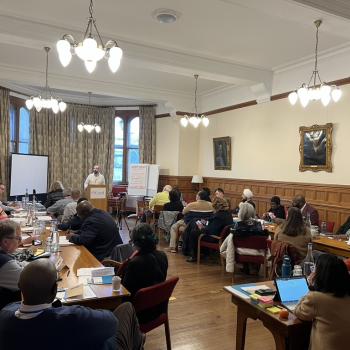Dr. S. Radhakrishnan, eminent philosopher and former president of India, confirmed Swami Vivekananda's views in his well-known book, The Hindu View of Life (p. 28-29):
In a sense, Hinduism may be regarded as the first example in the world of a missionary religion. Only its missionary spirit is different from that associated with the proselytizing creeds. It did not regard it as its mission to convert humanity to any one opinion. For what counts is conduct and not belief. Worshipers of different Gods and followers of different rites were taken into the Hindu fold. The ancient practice of vratyastoma, described fully in the Tandya Brahmana, shows that not only individuals but whole tribes were absorbed into Hinduism. Many modern sects accept outsiders. Devala Smriti lays down rules for the simple purification of people forcibly converted to other faiths, or of womenfolk defiled and confined for years, and even of people who, for worldly advantage, embrace other faiths.
In a recent article, writer Shreeram Tyambak Godbole of Bombay observes,
Hinduism ... has been assimilating into itself all those who have been willing, without offending anybody. Whoever from other religions adopted even outwardly the customs and manners of the Hindus could, in course of time, hope to get his progeny easily assimilated in the Hindu society. This process has been going on for the last two or two-and-a-half millenniums. The beginnings of this process can be seen in the sixty-fifth chapter of Mahabharata, Shantiparva, where Indra is described to have ordered Mandhatru to give all access to all foreigners, like the Yavanas, into the Vedic religion.
He gives a historical example:
[The] Bactrian Greeks had soon to run down to India as refugees, driven headlong by U-echis, when they were all admitted to the Hindu fold. The same fate the U-echis, the Sakas, the Kushans and the Huns had to face. The Kushan emperor, Kadphasis II, took to Siva worship so devoutly that on his coins he inscribed the image of the Lord Siva and had himself mentioned as the devotee of Siva. Huvishka and Vasudeva and their descendants also inscribed Lord Siva and his Nandi on their coins.... While the Abhirs became Vaishnavas, the Scythians and U-echis became Saivas.... Huns again became Saivas. The Hun King Mihirkula had inscribed on his silver coins 'Jayatu Vrshadhvajah' and 'Jayatu Vrshah' along with Siva's Trishula and his Nandi and his umbrella.... All the Bactrian Greeks, the U-echis, the Sakas, the Kushans, and the Huns are now so well assimilated into the Hindu society that their separate identity cannot at all be traced.
Our friend and compatriot in promoting Sanatana Dharma, Sri Ram Swarup (1920-1998), had this to say about the power of those who have converted to or adopted the Hindu faith:
Hitherto, Hindus knew only two categories: Hindus born in India and Hindu emigrants who went overseas during the last few centuries, often under very adverse conditions. But now we have also a new, fast-growing third category of those who adopt Hinduism by free choice. This is an important category, and traditional Hinduism should become aware of them. Their contribution to Hinduism is notable. Hindu thought is changing the intellectual-religious contour of Europe and America and attracting their best minds. In this thought, they also find the principle of their own self-discovery and recovery. The new religion of these countries is now really the 'New Age,' which is greatly worrying the Christian establishment. The Pope sees 'Eastern influences' in this new development. Pat Robertson, an influential American evangelist, finds that "the New Age and Hinduism -- it is the same thing." He complains, "We are importing Hinduism into America."
Must One Be Born in India to Be a Hindu?
At this time certain deeply ingrained misconceptions must also be erased, such as the mistaken notion -- postulated primarily by brahmin pandits and a few of the ShaMkaracharyas and parroted by Western academics -- that one must be born in India to be a Hindu. Of course, the Hindus of Nepal and Sri Lanka, the Hindus born in Bali and Malaysia, the Mauritian-born and Bangladesh-born Hindus would find such a concept very strange indeed, and few in the world would question their Hinduness. But the issue is often raised in America and Europe. Italian-born Swami Yoganandagiri bravely tackled this issue in his nation, as reported in our international magazine, Hinduism Today.
Swami explained, "We have to overcome a misunderstanding asserted by Italian scholars that one has to be born in India to be a Hindu. Our sanga also hopes to spread the authentic Hindu culture among Italians who take yoga as just a sweet gymnastic."




